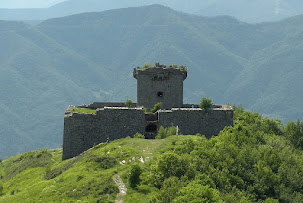League of Italian states band together to send the French army home
 |
| A 19th century painting of Charles VIII of France (left) at the Battle of Fornovo |
A French army took to the battlefield against combined troops from Venice, Milan, and Mantua. Soldiers were killed and wounded on both the French and the Italian sides, but the smaller French army claimed victory afterwards. However, it was also later celebrated as a victory against the French by Venice and Mantua.
After the battle, the French army were able to leave Italy safely, but they had to give up all the territory and valuables they had taken while they had been occupying the Italian peninsula.
It was just the start of a series of conflicts that were to take place in different parts of the peninsula between 1494 and 1559 between France, Spain, and the Holy Roman Empire, with various Italian states joining in on both sides. There was also some involvement from England, Switzerland, and the Ottoman Empire during the 150 years that the Italian Wars lasted.
The young King of France, Charles VIII, wanted to be a hero for the Christians in Europe and put a stop to the power of the Ottoman Turks. He decided that he would need to control the south of Italy in order to be able to do this and so he set out to claim the Kingdom of Naples.
He made agreements with his neighbouring countries by giving money to Henry VII of England and land to Ferdinand II of Spain and the Holy Roman Emperor, Maximilian.
Helped by Swiss mercenaries, Charles VIII moved through Italy easily and entered Naples in February 1495.
However, worried by the speed of his advance, some Italian states formed a Holy League with Pope Alexander VI, the Holy Roman Emperor, and the Kings of England and Spain.
After receiving news about the League being formed against him, Charles VIII left some of his troops behind to guard Naples, and marched north again with the rest of his army.
 |
| A depiction of Charles VIII leading his army into Florence in 1494 |
Meanwhile the Venetians and their allies set up camp near Fornovo di Taro in June and waited for the French army to arrive.
Knowing that his enemies were now growing in number and that he was running out of supplies, Charles decided on July 6 he would have to fight.
The League was stationed on the right side of the Taro river with the French troops on the left bank.
The French started the battle near Parma on this day more than 500 years ago by firing their cannons to frighten their enemies and then sent their heavy cavalry to charge forward. After the French had managed to break through the Italian lines, Charles marched his troops into Lombardy and from there he was able to return to France safely.
Both sides said they had won the Battle of Fornovo after the event, and Francesco Gonzaga, the Marquess of Mantua, even commissioned a painting, Madonna della Vittoria, to commemorate the victory.
But the French had come up against a much larger army and had still been able to continue their march home.
King Ferdinand II returned to Naples with a Spanish fleet and quickly won back the city and Pope Alexander VI congratulated the Venetians on gaining ‘immortal fame’ by freeing Italy.
The main loser at the end of this battle was the Italian peninsula, because other countries in Europe now realised it was a rich land, divided into lots of small states that were easy to conquer. For the next 150 years, the peninsula was to become a battleground for the main European powers.
 |
| The Church of Santa Maria Assunta is the most important religious building in Fornovo |
Fornovo di Taro is a town in the province of Parma, in the Italian region Emilia-Romagna, located about 100km (62 miles) west of Bologna and about 25km (16 miles) southwest of Parma. It is situated where the Po Valley meets the Lunigiana Valley. Fornovo was an important stop in the Middle Ages on the pilgrims' road to Monte Bardone, along the Via Francigena. The town acquired a significant place in Italian military history for a second time in April, 1945 when it was liberated from Nazi occupation by soldiers from the Brazilian Expeditionary Force fighting with the Allies. Under the command of General João Baptista Mascarenhas de Morais, the Brazilians marched into Fornovo at the conclusion of the four-day Battle of Collecchio. In the centre of the village one of the most important parish churches of the area, the church of Santa Maria Assunta, houses narrative friezes and sculptural pieces from the Antelami school.
 |
| Parma is the home of Parmigiano Reggiano, one of Italy's most famous cheeses |
Parma is an historic city in the Emilia-Romagna region, famous for its Prosciutto di Parma ham and Parmigiano Reggiano cheese, the true ‘parmesan’. In 1545 the city was given as a duchy to the illegitimate son of Pope Paul III, whose descendants ruled Parma till 1731. The composer, Verdi, was born near Parma at Busseto and the city has a prestigious opera house, the Teatro Regio, and a conservatory named in honour of Arrigo Boito, who wrote the libretti for many of Verdi’s operas. An elegant city with an air of prosperity common to much of Emilia-Romagna, Parma’s outstanding architecture includes an 11th century Romanesque cathedral and the octagonal 12th century baptistery that adjoins it, the church of San Giovanni Evangelista, which has a beautiful late Mannerist facade and bell tower, and the Palazzo della Pilotta. The palazzo houses the Academy of Fine Arts, the Palatine Library, the National Gallery and an archaeological museum.
Also on this day:
1849: The death of Goffredo Mameli, writer of the Italian national anthem
1942: The death of Sicilian Mafia-buster Cesare Mori
2002: The death of wrongly imprisoned bombing suspect Pietro Valpreda



































